Bulletin – September 2017 Australian Economy Covered Bonds in Australia
- Download 729KB
Abstract
Since their introduction in Australia in 2011, the stock of covered bonds has grown to around $80 billion, or around 15 per cent of Australian financial institutions' long-term debt. Covered bonds are a form of secured funding backed by both the issuer and a specific pool of assets. In practice, covered bonds are typically issued by banks and secured against pools of residential mortgages. Since they are secured against assets, covered bonds provide increased protection for lenders. As a result, they can be issued at lower yields and longer tenors than unsecured bonds and can be easier to issue during periods of market stress. However, covered bonds can reduce the protection of other unsecured creditors who then may require extra return.
Introduction
The Australian covered bond market first came into existence in 2011 when the Australian Government introduced legislation allowing covered bonds to be issued.[1] Since then, the amount of covered bonds on issue has grown significantly and represents around 15 per cent of Australian financial institutions' total long-term debt. With around $80 billion on issue, the Australian covered bond market has become almost as large as the asset-backed securities market (Graph 1).
Issuance of covered bonds by financial institutions varies significantly across countries. For example, the covered bond market in the euro area is well established and accounts for around half of European banks' long-term debt. In contrast, the United States has no specific covered bond legislation and therefore almost no covered bonds are issued by US banks.[2] Globally, the covered bond market grew strongly up to 2013, but has contracted in recent years (Graph 2).[3] Issuance of covered bonds by European banks has slowed following a reduction in credit growth, a declining amount of eligible collateral in Germany after the withdrawal of public guarantees to public banks and increased issuance of other types of bonds.[4]
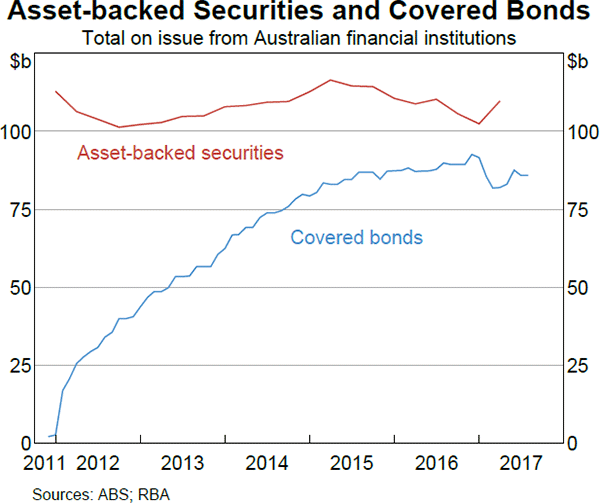
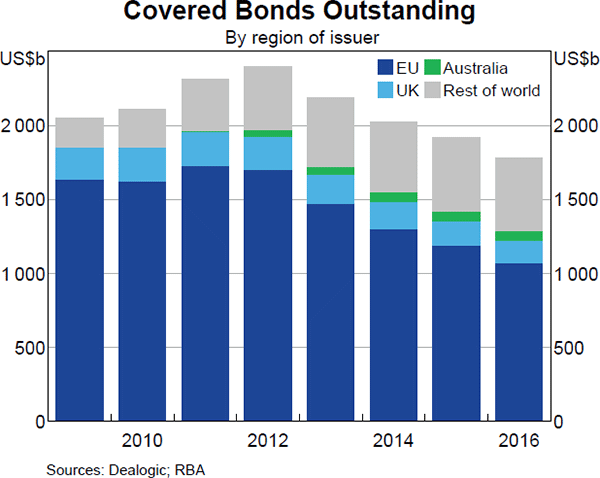
This article explains how covered bonds work and looks at the evolution of the Australian covered bond market, including the tenor, pricing and currency of issuance. Even though the market has grown rapidly, there are limits to how much further it can expand.
What is a Covered Bond?
Covered bonds are a form of secured funding for financial institutions. They are secured by a pool of high-quality assets – the ‘cover pool’ – typically mortgages. Covered bonds have the following essential features:
- The bond is issued by – or bondholders otherwise have full recourse to – a financial institution that is subject to public supervision and regulation.
- Bondholders have a claim against a cover pool of financial assets in priority to the unsecured creditors of the financial institution.
- The financial institution has an ongoing obligation to maintain sufficient assets in the cover pool to satisfy the claims of covered bondholders at all times.
- The obligations of the financial institution in respect of the cover pool are supervised by public or other independent bodies.[5]
The history of covered bonds
The origin of covered bonds can be traced back to the late 18th century, when they were an important source of public funding for Prussia after the Seven Years' War. The concept spread throughout Europe and by the late 19th century many European countries had a covered bond market.
The covered bond market declined in importance in the mid 20th century as capital markets developed and retail deposits grew strongly, which provided the banking system with a stable source of funding for mortgage lending. The covered bond market was revived towards the end of the 20th century amid regulatory changes. An important change was a 1988 European Union (EU) Directive, which established common characteristics of covered bonds and led to greater harmonisation of legal frameworks in the region.[6] The creation of ‘jumbo’ covered bonds in 1995 was also important to the market's development as it boosted liquidity and attracted more investors.[7]
Australian covered bond structure
Until the introduction of enabling legislation in 2011, authorised deposit-taking institutions (ADIs) had previously been prohibited from issuing covered bonds, because doing so would have been in conflict with Australia's depositor preference regime.[8] Under the Banking Act 1959, depositors are given priority (above that of other unsecured creditors) over the Australian assets of an ADI in the event that an ADI defaults. But in foreign jurisdictions, covered bond holders typically have a higher claim than depositors on a bank's assets in default. The Australian legislation therefore specifies that if the cover pool is insufficient to pay the full claims of the covered bond holders, their residual claims rank below deposit holders but at the same level as holders of senior debt. It also contains a limit on the total volume of covered bonds an ADI may issue, to 8 per cent of its total Australian assets. This limits the extent to which assets can be made unavailable to depositors in the event of default.
Covered bonds were first introduced in Australia with the intention of providing ADIs with an alternative source of finance that could be useful during future times of market stress.[9] This followed the experience of the global financial crisis, when market stress caused some credit markets internationally to seize up.[10] That experience had required the Australian Government to introduce the Guarantee Scheme for Large Deposits and Wholesale Funding to address funding pressures.[11] To ensure covered bonds could address this need without a government guarantee, the legislation included provisions to ensure the quality of the cover pools:
- allowing only limited types of assets to be used in the cover pool
- limiting loan-to-valuation ratios for mortgages in the cover pool
- requiring that the value of the cover pool assets must be at least 103 per cent of the face value of outstanding covered bonds (see Appendix A for further details on the legislative features).
By having recourse to a pool of assets, covered bonds share similarities with asset-backed securities such as residential mortgage-backed securities (RMBS). However, the main difference between the two is that RMBS depend only on the underlying pool of mortgages to pay the security holders, while covered bonds depend on the issuer to pay the security holders, and the assets in the cover pool are used only in the event of default.[12] Another difference in the Australian market is that ADIs do not have an explicit limit for the share of funding they can source from securitisation, while cover pool assets are capped at 8 per cent of an ADI's Australian assets.[13]
The assets inside a cover pool are held by a special purpose vehicle (SPV). This enables the assets to be separately identified and monitored by the ‘cover pool monitor’, a registered auditor that ensures the accuracy of cover pool information. In the event of an issuer default, the SPV is required to meet the covered bond obligations using the cash flows generated from the cover pool assets. Despite this ring-fencing of the assets for bankruptcy purposes, the covered bonds are direct, unconditional obligations of the issuing bank and the assets remain on the issuer's balance sheet for the purposes of accounting, tax and capital adequacy.
The Australian Prudential Regulation Authority (APRA) requires issuers to maintain clear rules for how assets are moved between the issuer's balance sheet and the SPV, covering things such as how assets are valued and what entity is responsible for administering the mortgages. In most circumstances, assets can be freely moved back from the SPV to the ADI's balance sheet. Instances where the assets cannot be moved back to the ADI's balance sheet include an event of default of the issuer or if the assets are required to meet the legislated 103 per cent minimum level of collateral in the cover pool.
There are legislative restrictions on the types of assets allowed in cover pools, and issuers of covered bonds can also set their own guidelines for what assets are eligible. For example, most issuers do not allow mortgages past 30 days in arrears to be entered into the cover pool. Additionally, while the legislation allows for commercial mortgages, Australian banks have only issued covered bonds backed by residential mortgages.
Risks and protections for investors
Covered bonds typically receive AAA credit ratings from the major rating agencies, mainly because:
- the issuer's credit rating is sufficiently high. The more highly rated an issuer, the easier it is to obtain a AAA rating on a covered bond
- the quality of the collateral included in the cover pool is sufficiently high. Higher-quality loans (such as loans with lower loan-to-valuation ratios (LVRs) or a longer history of repaying the mortgage on time) enhance the credit quality of the covered bonds
- the issuer commits to provide extra collateral in the cover pool.
The issuer's credit rating has a significant impact on the credit rating of covered bonds. This is because covered bonds usually function like other unsecured debt instruments, with the issuer responsible for meeting coupon and principal payments. In Australia, the issuers of covered bonds are relatively highly rated, with credit ratings of around AA or A; it is easier for these issuers to achieve AAA ratings on their covered bonds, compared with lower-rated issuers.
In the event that the issuer defaults, a key risk faced by covered bond investors is that the assets in the cover pool are insufficient to cover the interest and principal payments on time. This is a particular concern given the mismatch between a covered bond's interest rate and maturity date and those of the assets in the cover pool. For example, covered bonds are usually fixed-rate securities with an average maturity of less than seven years, while the residential mortgages in the cover pool are typically floating-rate with generally longer legal maturity dates (20 to 30 years) and uncertain actual repayment dates. That means, in the event of default of the issuer, the cover pool assets may need to be sold to meet the payments of the covered bonds. Given the generally illiquid nature of pools of residential mortgages, the timely sale of the cover pool assets is a potential concern for covered bond investors.
Some of these risks can be lessened by using hedging instruments, such as interest rate swaps, or by adding certain structural features to the covered bonds. Two common structural features that address these concerns are ‘committed over-collateralisation’ and ‘soft bullet’ securities.
‘Committed over-collateralisation’ is a commitment by the issuer to provide assets in the cover pool significantly above the value of covered bonds on issue. For example, the major banks generally agree to provide cover pool assets worth around 110 per cent of the value of covered bonds on issue. If the assets in the cover pool were to fall below the committed level, the major credit rating agencies may change their credit rating for the respective covered bond.[14]
Issuing ‘soft bullet’ securities is another way that covered bond issuers can reduce repayment risk for investors. A ‘hard bullet’ security repays its entire principal on a specified date. A soft bullet security also has a set maturity date where the entire principal is due to be repaid, but comes with the option to extend the maturity of the security by a set time (usually 12 months). Triggers for the maturity extension can be the default of the issuer or the consent of the bondholders. The maturity extension provides time to find a buyer for the pool of assets and reduces the risk of a ‘fire sale’ during a period of market stress. Interest still accrues on the covered bond during the extension period.
Recently, one Australian bank announced that it would issue covered bonds with a conditional pass-through structure, the first covered bond of this type in Australia.[15] Under this structure, covered bonds have a set maturity date where the entire principal is due to be repaid. However, if the issuer defaults, the maturity date is extended significantly and interest and principal payments from the cover pool mortgages are passed through to the bondholders, similar to an RMBS structure. This removes the risk of a forced sale of the cover pool assets in the event of issuer default. In addition, the pass-through structure makes it easier for institutions to obtain AAA ratings on their covered bonds, since the rating will depend more on the quality of the cover pool assets and less on the issuer's rating.
Assets backing covered bonds
In Australia, there are over 400,000 mortgages (with an average size of $280,000) backing covered bonds (Graph 3). Each month, covered bond issuers produce publicly available snapshots of these mortgages. The quality of the loans affects the credit rating of covered bonds. Similar to RMBS, ratings agencies take into account individual mortgage characteristics such as seasoning (the time since the mortgage was originated or refinanced), the LVRs of each mortgage, arrears rates, geographic concentration, and the split between investor and owner-occupier loans.
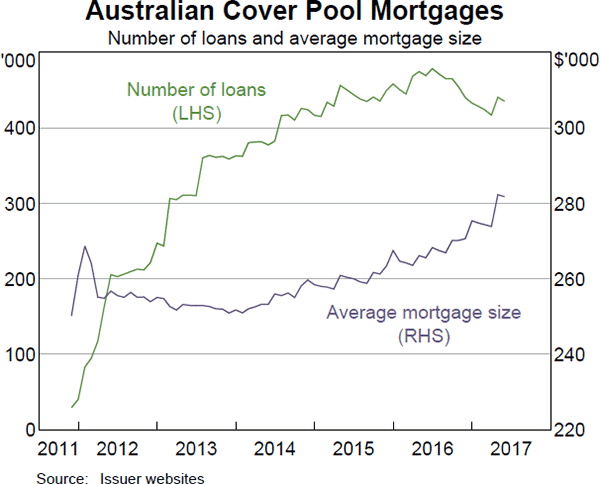
The mortgages backing covered bonds in Australia have weighted-average LVRs of around 60 per cent and this has been little changed since 2012 (Graph 4).[16] The average seasoning of mortgages has been between 3½ and 4 years since 2014. These characteristics are similar to mortgages that underlie RMBS when they are first issued. Other characteristics of mortgages in cover pools, such as average size and average mortgage rate, appear similar to data for all Australian mortgages.
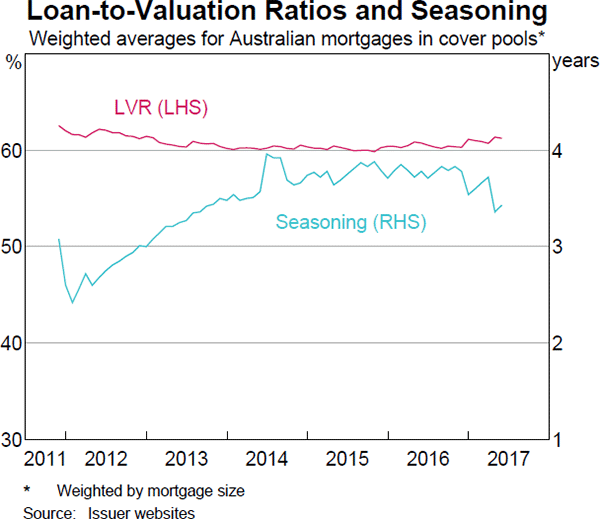
Ratings agencies assign lower credit ratings to pools of mortgages that are geographically concentrated. In practice, the geographic distribution of mortgages in cover pools appears to follow Australia's population shares by state (Graph 5). The largest difference is for Queensland, which has around 20 per cent of Australia's population but only around 16 per cent of mortgages in cover pools, by value. NSW/ACT has the largest over-representation, with 37 per cent of mortgages in cover pools compared with around 33½ per cent of Australia's population. There has been a slight increase in NSW's share of mortgages in recent years. More generally, state shares are also likely to be affected by differences in household income levels and average mortgage sizes. For example, states with higher household income levels may have larger average mortgage sizes and therefore a larger share of mortgages, given those households' greater ability to service larger mortgages.
Recent Developments in the Covered Bond Market
Since their introduction in Australia in October 2011, covered bonds have grown to around $80 billion on issue, with most issuance coming from the major banks. After a large volume of issuance initially, covered bonds have remained a small but stable share of bank's total bond issuance (Graph 6). Recent issuance has mainly been used to refinance maturities. As noted above, the legislation limits the assets that ADIs can provide into the cover pool to 8 per cent of their resident assets. In practice, the major banks issue far less than this limit (Graph 7). This provides a buffer for any future period of market stress, where issuing covered bonds may be easier than issuing unsecured bonds.
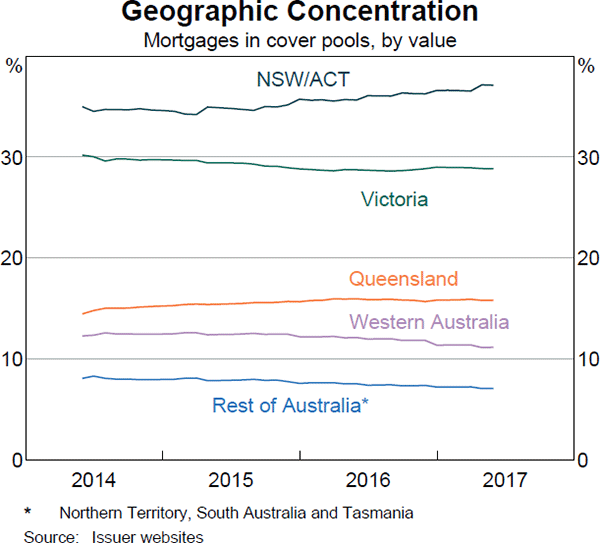
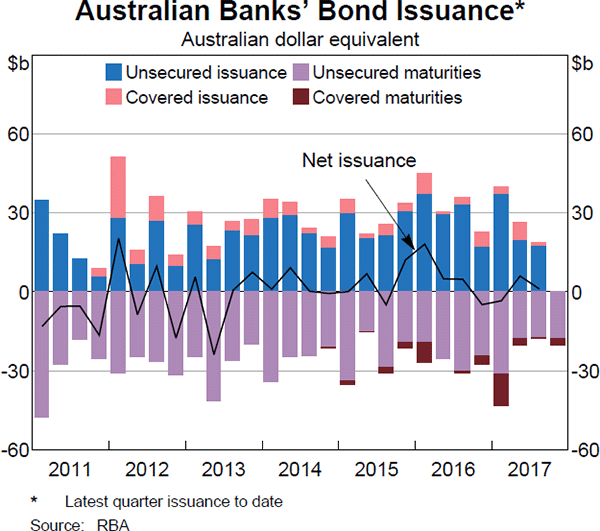
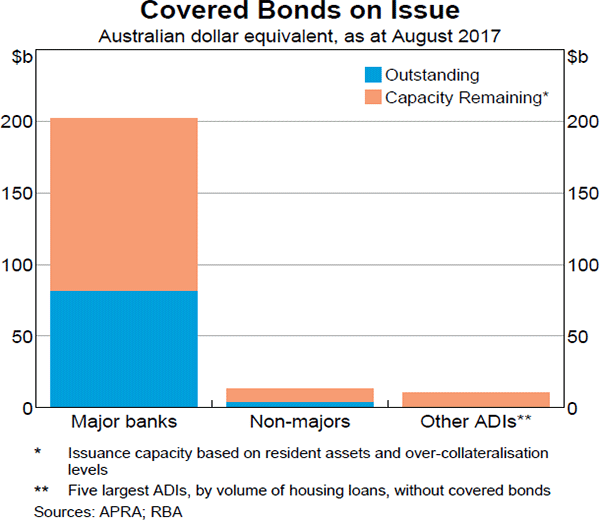
Pricing of covered bonds for Australian banks at primary issuance was initially similar to secondary market pricing on unsecured bonds, suggesting that there was little pricing advantage compared with unsecured bonds (Graph 8). This could have reflected the possibility that investors were initially unfamiliar with the new instrument, along with generally stressed market conditions in 2011/12 amid concerns about the European sovereign debt market. Since then, spreads of covered bonds to Australian Government Securities (AGS) at primary issuance have generally been tighter than for unsecured bonds. Secondary market spreads of covered bonds have been around 20 basis points below similar spreads for unsecured bonds over recent years (Graph 9).
However, it should be noted that while covered bonds have lower yields than similar unsecured bonds, they may not necessarily reduce an institution's overall borrowing cost. Investors in unsecured debt could theoretically demand a higher return if their investment is subordinated to a substantial volume of covered bonds. So overall, the lower cost of covered bonds could be offset by higher costs of unsecured bonds.
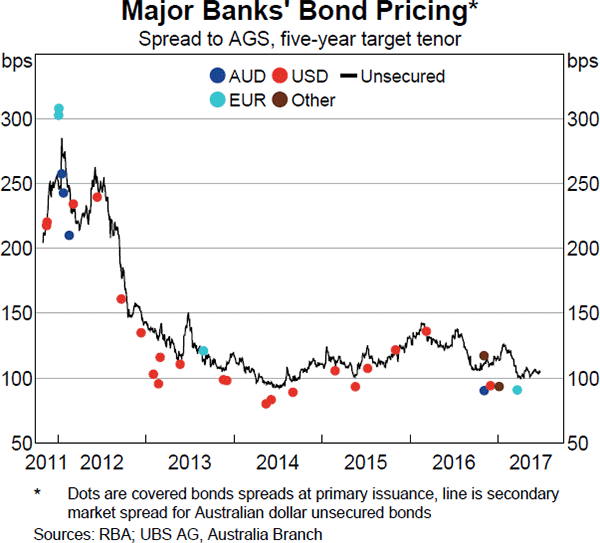
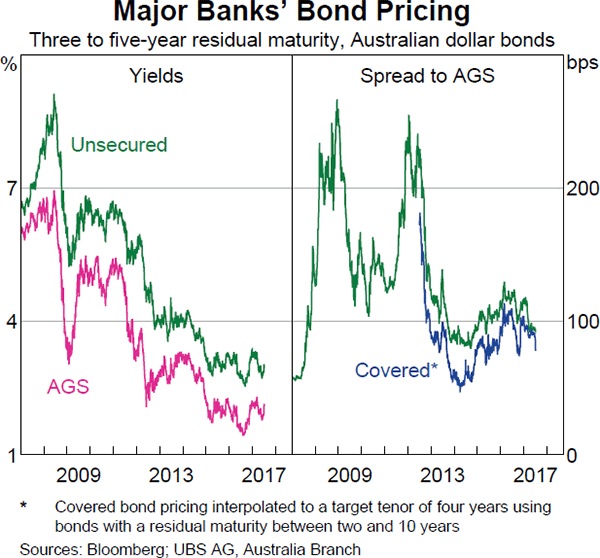
Covered bonds have other potential advantages for issuers such as diversifying the types of investors to include those that may not invest in unsecured debt. They may also allow the issuer to borrow for longer tenors than in the case of other debt instruments. For instance, tenors at primary issuance for covered bonds are, on average, one to two years longer than unsecured bonds (Graph 10). Most covered bonds issued by Australian banks are around the 5- and 10-year tenor, with around one-quarter of issuance for tenors longer than 10 years (Graph 11). Issuing for longer tenors may also help banks extend the average maturity of their liabilities to meet regulatory requirements, such as the net stable funding ratio.


Given Europe's well-established covered bond market, many Australian institutions undertake a large share of covered bond issuance in the euro area.[17] Currently just under half of Australian banks' covered bonds are denominated in euros, compared with around 15 per cent of unsecured bank bonds (Graph 12). The US dollar is an important funding currency for both covered and unsecured bonds, with around one-third of issuance for both types of bonds denominated in US dollars. Covered bond issuance in Australian dollars has declined markedly in recent years, offset by an increase in euro-denominated issuance.
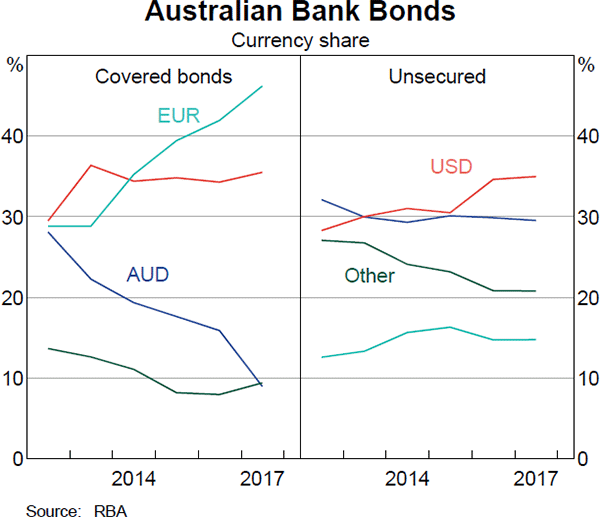
Conclusion
The market for Australian covered bonds has grown significantly since enabling legislation was enacted in 2011. The stock outstanding of covered bonds is around $80 billion and covered bond issuance has become a small but stable share of Australian banks' total bond issuance. By having recourse to a pool of assets, covered bonds provide investors increased protection against default. Covered bonds also allow for issuance at longer tenors than unsecured bonds and provide issuers access to a different group of investors. Pricing of covered bonds has generally been 20 basis points tighter than similar unsecured bonds and issuance has been mainly in the European market.
Appendix A: Key Legislative Features of Covered Bonds in Australia
The Banking Amendment (Covered Bonds) Act 2011 specifies that the following assets are allowed in cover pools in Australia:
- residential mortgage
- commercial mortgage
- at-call deposit with an ADI
- bank-accepted bill or certificate of deposit with less than 100 days to maturity that is Reserve Bank repo-eligible
- Australian Government Security or semi-government security
- derivatives that hedge risks related to the assets in the cover pool or liabilities secured by the cover pool.
The legislation also discourages loans above certain LVRs; residential mortgages with an LVR greater than 80% are permitted in the cover pool but the value of the mortgage exceeding 80 per cent is not counted as an asset. Similarly, the portion of a commercial mortgage that exceeds 60 per cent LVR is not counted as an asset in a cover pool.
Cover pool assets also have three important legislative requirements:
- The cover pool must be monitored by a registered auditor.
- An ADI cannot issue a covered bond if the total cover pool assets would exceed 8 per cent of the ADI's resident assets.
- Cover pool assets must be at least 103 per cent of the face value of covered bonds.
Footnotes
The author is from Domestic Markets Department. [*]
For this article, ‘Australian covered bonds’ refers to covered bonds issued by Australian financial institutions. The Banking Amendment (Covered Bonds) Act 2011 was introduced to provide an alternative source of finance that could be useful during times of market stress. [1]
See Batchvarov and Caris (2016). [2]
Issuance in Germany slowed from 2003, see Packer, Stever and Upper (2007) for more information. [3]
For example, European banks have increased the issuance of bonds that can be counted towards their total loss-absorbing capacity. [4]
See ECBC (2017) for more information about the essential features of covered bonds. [5]
This refers to the 1988 amendment of the undertakings of collective investment in transferable securities (UCITS) Directive; see Council Directive 88/220/EEC. [6]
The current definition for jumbo covered bonds includes issuance of a single bond line of greater than €500 million. [7]
Before 2011, ADIs were not permitted by the Australian Prudential Regulation Authority (APRA) to issue covered bonds; see Banking Amendment (Covered Bonds) Act 2011 for the details of the enabling legislation. [8]
Reducing ‘the risks associated with dislocation in one or more credit markets’ was highlighted as a benefit of introducing covered bonds, see Lonsdale (2011) for a discussion of the covered bond legislation. [9]
Covered bond issuers' access to debt markets was also disrupted during the crisis, see RBA (2011). [10]
See Schwartz and Tan (2016) for more information on the Australian Government Guarantee Scheme. [11]
For more information about the structural features of RMBS, see Arsov, Kim and Stacey (2015). [12]
APRA recognises that if an ADI has a large share of securitised funding, this may conflict with depositor preference and that ADIs ‘must prudently diversify their funding sources’, but is not currently proposing to limit securitisation; see Littrell (2013). [13]
Moody's (2016) defines the commitment as a ‘commitment [that] cannot be reversed or reduced at the discretion of the issuer without the issuer (or its directors) facing material negative consequences’. [14]
See Bank of Queensland (2017). [15]
Here LVR is calculated using the current loan balance of the mortgage and the most recent valuation of the property. [16]
For Australian covered bonds, the location of issuance and the currency of issuance are usually related. For example, nearly all Australian covered bonds denominated in US dollars have been issued in the US market. [17]
References
Arsov I, IS Kim and K Stacey (2015), ‘Structural Features of Australian Residential Mortgage-backed Securities’, RBA Bulletin, June, pp 43–58.
Bank of Queensland (2017), ‘Covered Bonds’. Available at <http://www.boq.com.au/covered-bonds.htm>.
Banking Amendment (Covered Bonds) Act 2011 (No. 125, 2011). Available at <https://www.legislation.gov.au/Details/C2011A00125>.
Batchvarov A and A Caris (2016), ‘United States’, 2016 ECBC European Covered Bond Fact Book, pp 495–499.
Council Directive 88/220/EEC, ‘Amending as regards the investment policies of certain undertakings for collective investments in transferable securities (UCITS)’, 22 March 1988. Available at < http://eur-lex.europa.eu/legal-content/EN/TXT/HTML/?uri=CELEX:31988L0220&from=EN>.
ECBC (European Covered Bond Council) (2017), ‘Essential Features of Covered Bonds’. Available at <https://hypo.org/ecbc/covered-bonds/>.
Littrell C (2013), ‘Prudential Reform in Securitisation’, Speech at Australian Securitisation Forum, Sydney, 11 November. Available at <http://www.apra.gov.au/Speeches/Pages/Prudential-reform-in-securitisation.aspx>.
Lonsdale J (2011), ‘Understanding the Key Elements of Covered Bonds Legislation’, Speech at Insto Covered Bonds Congress 2011, Sydney, 16 August. Available at <http://www.treasury.gov.au/PublicationsAndMedia/Newsroom/Speeches/2011/covered-bonds-legislation>.
Moody's (2016), ‘Moody's Approach to Rating Covered Bonds’, Rating Methodology, 19 December.
Packer F, R Stever and C Upper (2007), ‘The covered bond market’, Quarterly Review, Bank for International Settlements, September, pp 43–55.
RBA (2011), ‘Box A: Covered Bonds’, Financial Stability Review, March, pp 17–19.
Schwartz C and N Tan (2016), ‘The Australian Government Guarantee Scheme: 2008–15’, RBA Bulletin, March pp 39–46 .